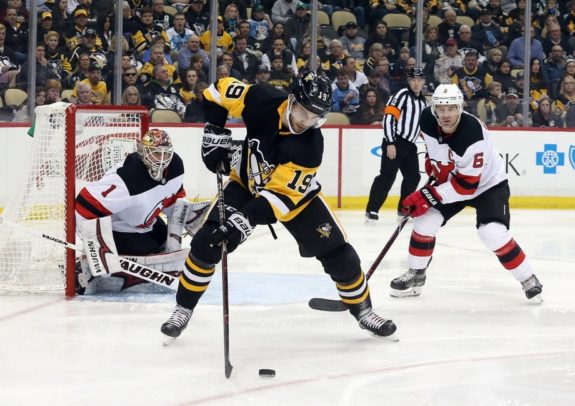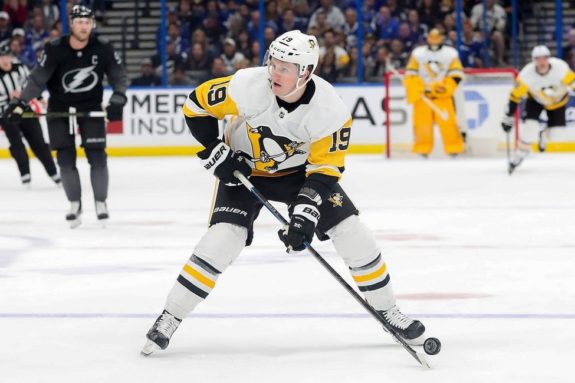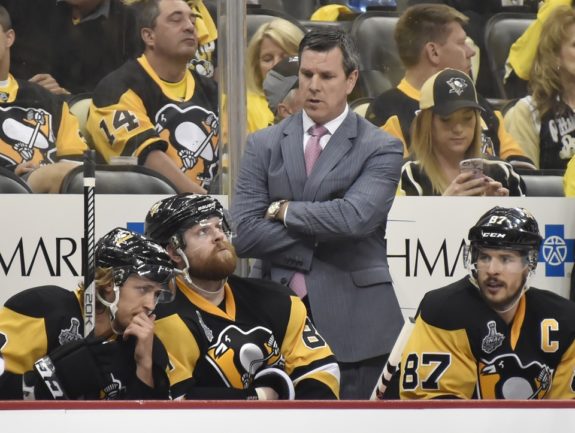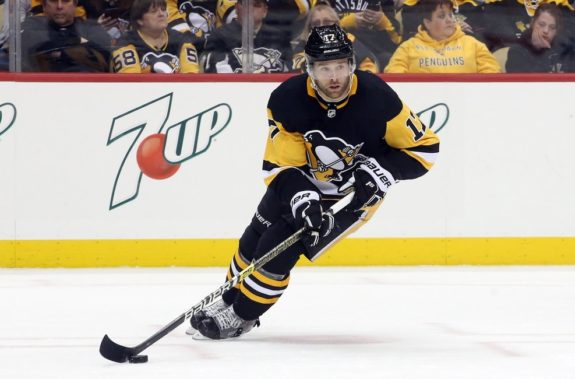During last season’s stretch run, Pittsburgh Penguins general manager Jim Rutherford made a series of seemingly minor moves to try to bolster the playoff roster. Perhaps the best of those moves was acquiring forwards Nick Bjugstad and Jared McCann from the Florida Panthers in exchange for Derick Brassard and Riley Sheahan. The Penguins also sent a second-round pick and two fourth-rounders in the deal.
What the Pens Gave Up
When the Penguins acquired Brassard from the Ottawa Senators in a three-team trade during the 2017-18 season, they thought they were getting a top-six quality forward with a ton of playoff experience and success. For one reason or another, he never quite jelled in the Penguins system, leading Rutherford to unload him for a pair of more complementary pieces.

Sheahan performed admirably as a third-line center for the team, but wasn’t fast or dynamic enough to truly thrive in head coach Mike Sullivan’s system.
McCann and Bjugstad by the Numbers
While both players saw an uptick in production once they joined the Pens, neither were earth-shattering. Bjustad played exactly 32 games with each squad, and while he scored more points with the Penguins (14) than with the Panthers (12), it was his versatility and ability to be effective at both center and wing that helped the Pens.
Bjugstad compares favorably to Sheahan, who had just 10 points in 49 games in Pittsburgh. Also, Sheahan’s plus/minus on the Pens was minus-seven, while Bjugstad finished at plus-four.
McCann played 32 games with the Penguins, compared to 46 with the Panthers. While he scored one less point (17) with the Penguins than with the Panthers, he saw his plus/minus jump from minus-nine to plus-eight between the two clubs. Clearly, the Penguins were much better with McCann on the ice than the Panthers were.

In 40 games with the Penguins, Brassard accounted for 15 points and a minus-six plus/minus. The 31-year-old vet only played 10 games as a Panther before being shipped to the Colorado Avalanche. Overall, he played 70 games for three teams and finished with 23 points and a minus-19 rating.
Where They Can Be Better
There’s no doubt Bjugstad is a quality player, and being a center on the Penguins affords him the luxury of playing behind Sidney Crosby and Evgeni Malkin. That means he doesn’t have to be the focal point of the Penguins attack. It also means he has more of a leash to find his potential.
As of now, the 6-foot-6 playmaker hasn’t lived up to his first-round selection in 2010, but his size, reach and decision making could result in a breakout statistical year in Pittsburgh. McCann was a bit of an afterthought in the trade but ended up being the more productive of the two players. Maximizing his ability will be more on Sullivan and his coaching staff than on the player himself.

The good news is that Sullivan likes to move wingers up and down the lineup, which McCann is adept at, so it will be up to the staff to figure out when and where to move him in order to put him in the best situation to succeed.
So, What’s the Outlook?
One of the most important things to remember about McCann is that when the season begins he’ll be just 23 years old. What we saw in the second half with Pittsburgh last season could be just scratching the surface of his potential.
Now, I don’t think he’s going to come out and score 30 goals or reach 80 points, but I do think you can look to another Penguin to gauge what kind of player you can expect McCann to be. If you look at his total numbers from last season, he scored exactly the same amount of points (35) as Bryan Rust. Why’s that significant?
Well, because they’re similar players. Both are high-motor guys with above-average speed, and both can play up and down the lineup – instantly energizing a line. Their type of style fits exactly the kind of game Sullivan likes to play. Also, both are extremely adept on the penalty kill. Rust had two shorthanded goals last season, while McCann amassed four.

While not a complete game-changer, the Pens could do a lot worse than having another – younger – Rust on their squad. While McCann is a ball of energy, I expect Bjugstad to be more of a calming presence. His ability to play at multiple spots gives Sullivan some flexibility, which is good news. Plus, his size and potential to run the second power play unit adds diversity to the Penguins attack. As much as the trade seemed to work out a season ago, I’d expect this duo to make Rutherford look very good in 2019-20.